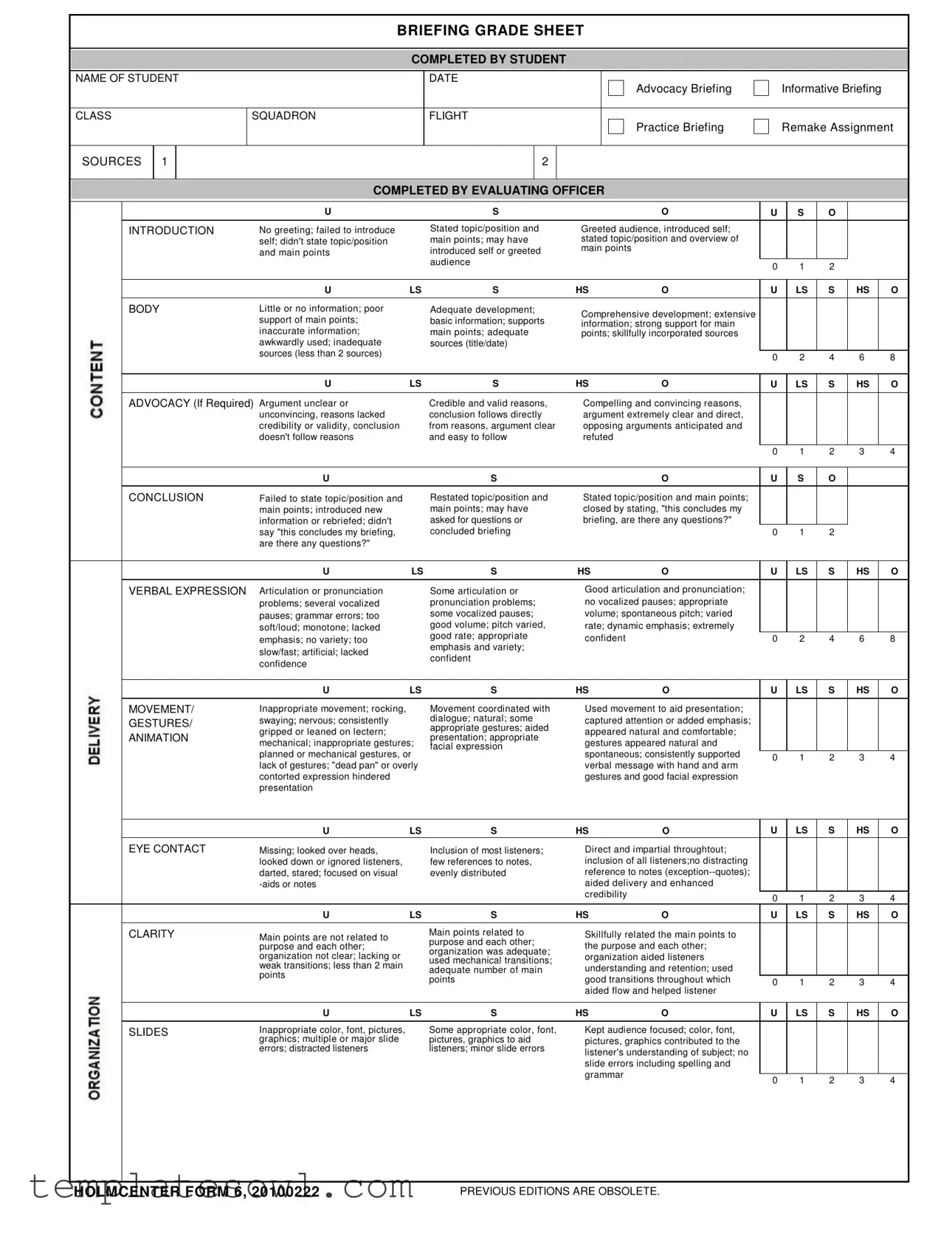|
NAME OF STUDENT |
|
|
DATE |
|
|
|
|
Advocacy Briefing |
|
|
|
Informative Briefing |
|
|
|
|
|
|
|
|
|
|
|
|
|
|
|
|
|
|
|
|
|
|
|
|
|
|
|
|
|
|
|
|
|
|
|
|
|
|
|
|
|
|
|
|
|
|
|
CLASS |
|
|
SQUADRON |
|
FLIGHT |
|
|
|
|
Practice Briefing |
|
|
|
Remake Assignment |
|
|
|
|
|
|
|
|
|
|
|
|
|
|
|
|
|
|
|
|
|
|
|
|
|
|
|
|
|
|
|
|
|
|
|
|
|
|
|
|
|
|
|
|
|
SOURCES |
|
1 |
|
|
|
|
2 |
|
|
|
|
|
|
|
|
|
|
|
|
|
|
|
|
|
|
|
|
|
|
|
|
|
|
|
|
|
|
|
|
|
|
|
|
|
|
|
|
|
|
|
|
|
COMPLETED BY EVALUATING OFFICER |
|
|
|
|
|
|
|
|
|
|
|
|
|
|
|
|
|
|
|
|
|
|
|
|
|
|
|
|
|
|
|
|
|
|
|
|
|
|
|
|
|
U |
|
S |
|
|
|
|
O |
|
U |
|
S |
O |
|
|
|
|
|
|
|
|
|
|
|
|
|
|
|
|
|
|
|
|
|
|
|
|
|
|
INTRODUCTION |
No greeting; failed to introduce |
|
Stated topic/position and |
Greeted audience, introduced self; |
|
|
|
|
|
|
|
|
|
|
|
|
|
|
|
self; didn't state topic/position |
|
main points; may have |
stated topic/position and overview of |
|
|
|
|
|
|
|
|
|
|
|
|
|
|
|
and main points |
|
introduced self or greeted |
main points |
|
|
|
|
|
|
|
|
|
|
|
|
|
|
|
|
|
|
|
|
|
|
|
|
|
|
|
|
|
|
|
|
|
|
|
|
|
|
|
|
|
audience |
|
|
|
|
|
|
|
0 |
1 |
2 |
|
|
|
|
|
|
|
|
|
|
|
|
|
|
|
|
|
|
|
|
|
|
|
|
|
|
|
|
|
|
|
|
|
|
|
|
|
|
|
|
|
|
|
|
|
|
|
|
|
|
|
|
|
U |
LS |
S |
HS |
O |
|
U |
|
LS |
S |
HS |
|
O |
|
|
|
|
|
|
|
|
|
|
|
|
|
|
|
|
|
|
|
|
|
|
|
|
|
|
|
|
BODY |
|
|
Little or no information; poor |
|
Adequate development; |
Comprehensive development; extensive |
|
|
|
|
|
|
|
|
|
|
|
|
|
|
|
support of main points; |
|
basic information; supports |
|
|
|
|
|
|
|
|
|
|
|
|
|
|
|
|
information; strong support for main |
|
|
|
|
|
|
|
|
|
|
|
|
|
|
|
inaccurate information; |
|
main points; adequate |
|
|
|
|
|
|
|
|
|
|
|
|
|
|
|
|
points; skillfully incorporated sources |
|
|
|
|
|
|
|
|
|
|
|
|
|
|
|
awkwardly used; inadequate |
|
sources (title/date) |
|
|
|
|
|
|
|
|
|
|
|
|
|
|
|
|
|
|
|
|
|
sources (less than 2 sources) |
|
|
|
|
|
|
|
|
|
|
0 |
2 |
4 |
6 |
|
8 |
|
|
|
|
|
|
|
|
|
|
|
|
|
|
|
|
|
|
|
|
|
|
|
|
|
|
|
|
|
|
|
|
|
|
|
|
|
|
|
|
|
|
|
|
|
|
|
|
U |
LS |
S |
HS |
O |
|
U |
|
LS |
S |
HS |
|
O |
|
|
|
|
|
|
|
|
|
|
|
|
|
|
|
|
|
|
|
|
|
|
|
ADVOCACY (If Required) Argument unclear or |
|
Credible and valid reasons, |
Compelling and convincing reasons, |
|
|
|
|
|
|
|
|
|
|
|
|
|
|
|
unconvincing, reasons lacked |
|
conclusion follows directly |
argument extremely clear and direct, |
|
|
|
|
|
|
|
|
|
|
|
|
|
|
|
credibility or validity, conclusion |
|
from reasons, argument clear |
opposing arguments anticipated and |
|
|
|
|
|
|
|
|
|
|
|
|
|
|
|
doesn't follow reasons |
|
and easy to follow |
refuted |
|
|
|
|
|
|
|
|
|
|
|
|
|
|
|
|
|
|
|
|
|
|
|
|
|
|
|
|
|
|
|
|
|
|
|
|
|
|
|
|
|
|
|
|
|
|
|
|
|
|
|
|
|
0 |
1 |
2 |
3 |
|
4 |
|
|
|
|
|
|
|
|
|
|
|
|
|
|
|
|
|
|
|
|
|
|
|
|
|
|
|
|
|
|
|
U |
|
S |
|
|
|
|
O |
|
U |
|
S |
O |
|
|
|
|
|
|
|
|
|
|
|
|
|
|
|
|
|
|
|
|
|
|
|
|
|
|
CONCLUSION |
Failed to state topic/position and |
|
Restated topic/position and |
Stated topic/position and main points; |
|
|
|
|
|
|
|
|
|
|
|
|
|
|
|
main points; introduced new |
|
main points; may have |
closed by stating, "this concludes my |
|
|
|
|
|
|
|
|
|
|
|
|
|
|
|
information or rebriefed; didn't |
|
asked for questions or |
briefing, are there any questions?" |
|
|
|
|
|
|
|
|
|
|
|
|
|
|
|
say "this concludes my briefing, |
|
concluded briefing |
|
|
|
|
|
|
|
0 |
1 |
2 |
|
|
|
|
|
|
|
|
|
|
are there any questions?" |
|
|
|
|
|
|
|
|
|
|
|
|
|
|
|
|
|
|
|
|
|
|
|
|
|
|
|
|
|
|
|
|
|
|
|
|
|
|
|
|
|
|
|
|
|
|
U |
LS |
S |
HS |
O |
|
U |
|
LS |
S |
HS |
|
O |
|
|
|
|
|
|
|
|
|
|
|
|
|
|
|
|
|
|
|
|
|
|
|
VERBAL EXPRESSION |
Articulation or pronunciation |
|
Some articulation or |
Good articulation and pronunciation; |
|
|
|
|
|
|
|
|
|
|
|
|
|
|
|
problems; several vocalized |
|
pronunciation problems; |
no vocalized pauses; appropriate |
|
|
|
|
|
|
|
|
|
|
|
|
|
|
|
pauses; grammar errors; too |
|
some vocalized pauses; |
volume; spontaneous pitch; varied |
|
|
|
|
|
|
|
|
|
|
|
|
|
|
|
soft/loud; monotone; lacked |
|
good volume; pitch varied, |
rate; dynamic emphasis; extremely |
|
|
|
|
|
|
|
|
|
|
|
|
|
|
|
emphasis; no variety; too |
|
good rate; appropriate |
confident |
|
|
|
0 |
2 |
4 |
6 |
|
8 |
|
|
|
|
|
|
|
slow/fast; artificial; lacked |
|
emphasis and variety; |
|
|
|
|
|
|
|
|
|
|
|
|
|
|
|
|
|
|
|
|
|
|
confident |
|
|
|
|
|
|
|
|
|
|
|
|
|
|
|
|
|
|
|
|
|
confidence |
|
|
|
|
|
|
|
|
|
|
|
|
|
|
|
|
|
|
|
|
|
|
|
|
|
|
|
|
|
|
|
|
|
|
|
|
|
|
|
|
|
|
|
|
|
|
|
|
|
|
|
|
|
|
|
|
|
|
|
|
|
|
|
|
|
|
|
|
U |
LS |
S |
HS |
O |
|
U |
|
LS |
S |
HS |
|
O |
|
|
|
|
|
|
|
|
|
|
|
|
|
|
|
|
|
|
|
|
|
|
|
MOVEMENT/ |
Inappropriate movement; rocking, |
|
Movement coordinated with |
Used movement to aid presentation; |
|
|
|
|
|
|
|
|
|
|
|
GESTURES/ |
swaying; nervous; consistently |
|
dialogue; natural; some |
captured attention or added emphasis; |
|
|
|
|
|
|
|
|
|
|
|
gripped or leaned on lectern; |
|
appropriate gestures; aided |
appeared natural and comfortable; |
|
|
|
|
|
|
|
|
|
|
|
|
|
|
|
|
|
|
|
|
|
|
|
|
|
|
|
ANIMATION |
|
presentation; appropriate |
|
|
|
|
|
|
|
|
|
|
|
mechanical; inappropriate gestures; |
gestures appeared natural and |
|
|
|
|
|
|
|
|
|
|
|
|
|
|
|
facial expression |
|
|
|
|
|
|
|
|
|
|
|
|
|
|
|
planned or mechanical gestures, or |
spontaneous; consistently supported |
|
|
|
|
|
|
|
|
|
|
|
|
|
|
|
|
|
|
0 |
1 |
2 |
3 |
|
4 |
|
|
|
|
|
|
|
lack of gestures; "dead pan" or overly |
|
|
verbal message with hand and arm |
|
|
|
|
|
|
|
|
|
|
|
|
|
|
|
|
|
|
|
|
|
|
|
|
contorted expression hindered |
|
|
|
gestures and good facial expression |
|
|
|
|
|
|
|
|
|
|
|
|
|
|
presentation |
|
|
|
|
|
|
|
|
|
|
|
|
|
|
|
|
|
|
|
|
|
|
|
|
|
|
|
|
|
|
|
|
|
|
|
|
|
|
|
|
|
|
|
|
|
|
U |
LS |
S |
HS |
O |
|
U |
|
LS |
S |
HS |
|
O |
|
|
|
EYE CONTACT |
Missing; looked over heads, |
|
Inclusion of most listeners; |
Direct and impartial throughtout; |
|
|
|
|
|
|
|
|
|
|
|
|
|
|
|
looked down or ignored listeners, |
|
few references to notes, |
inclusion of all listeners;no distracting |
|
|
|
|
|
|
|
|
|
|
|
|
|
|
|
darted, stared; focused on visual |
|
evenly distributed |
reference to notes (exception--quotes); |
|
|
|
|
|
|
|
|
|
|
|
|
|
|
|
-aids or notes |
|
|
|
aided delivery and enhanced |
|
|
|
|
|
|
|
|
|
|
|
|
|
|
|
|
|
|
|
credibility |
|
|
|
0 |
1 |
2 |
3 |
|
4 |
|
|
|
|
|
|
|
|
|
|
|
|
|
|
|
|
|
|
|
|
|
|
|
|
|
|
U |
LS |
S |
HS |
O |
|
U |
|
LS |
S |
HS |
|
O |
|
|
|
|
|
|
|
|
|
|
|
|
|
|
|
|
|
|
|
|
|
|
|
CLARITY |
Main points are not related to |
|
Main points related to |
Skillfully related the main points to |
|
|
|
|
|
|
|
|
|
|
|
|
|
|
|
|
purpose and each other; |
the purpose and each other; |
|
|
|
|
|
|
|
|
|
|
|
|
|
|
|
purpose and each other; |
|
|
|
|
|
|
|
|
|
|
|
|
|
|
|
|
|
organization was adequate; |
|
|
|
|
|
|
|
|
|
|
|
|
|
|
|
organization not clear; lacking or |
|
organization aided listeners |
|
|
|
|
|
|
|
|
|
|
|
|
|
|
|
|
used mechanical transitions; |
|
|
|
|
|
|
|
|
|
|
|
|
|
|
|
weak transitions; less than 2 main |
|
understanding and retention; used |
|
|
|
|
|
|
|
|
|
|
|
|
|
|
|
|
adequate number of main |
|
|
|
|
|
|
|
|
|
|
|
|
|
|
|
points |
|
|
|
|
|
|
|
|
|
|
|
|
|
|
|
|
|
points |
good transitions throughout which |
0 |
1 |
2 |
3 |
|
4 |
|
|
|
|
|
|
|
|
|
|
|
|
|
|
|
|
|
|
|
|
|
aided flow and helped listener |
|
|
|
|
|
|
|
|
|
|
|
|
|
|
|
|
|
|
|
|
|
|
|
|
|
|
|
|
|
|
|
|
|
|
|
|
|
|
|
|
|
|
|
|
U |
LS |
S |
HS |
O |
|
U |
|
LS |
S |
HS |
|
O |
|
|
|
|
|
|
|
|
|
|
|
|
|
|
|
|
|
|
|
SLIDES |
Inappropriate color, font, pictures, |
|
Some appropriate color, font, |
Kept audience focused; color, font, |
|
|
|
|
|
|
|
|
|
|
|
|
|
|
|
graphics; multiple or major slide |
|
pictures, graphics to aid |
pictures, graphics contributed to the |
|
|
|
|
|
|
|
|
|
|
|
|
|
|
|
errors; distracted listeners |
|
listeners; minor slide errors |
listener's understanding of subject; no |
|
|
|
|
|
|
|
|
|
|
|
|
|
|
|
|
|
|
|
|
|
|
|
|
|
|
|
|
|
|
|
|
|
|
|
|
|
|
slide errors including spelling and |
|
|
|
|
|
|
|
|
|
|
|
|
|
|
|
|
|
|
|
grammar |
|
|
|
|
|
|
|
|
|
|
|
|
|
|
|
|
|
|
|
|
|
|
|
|
0 |
1 |
2 |
3 |
|
4 |
|
|
|
|
|
|
|
|
|
|
|
|
|
|
|
|
|
|
|
|
|
|
|
|
|
|
|
|
|
|
|
|
|
|
|
|
|
|
|
|
|
|
|
|
|


